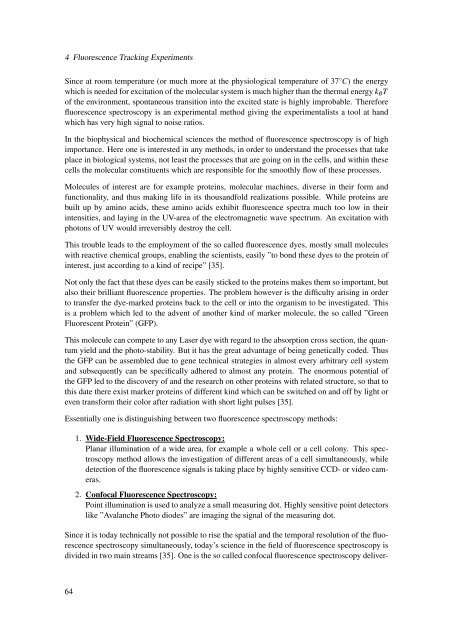Diffusion Processes with Hidden States from ... - FU Berlin, FB MI
Diffusion Processes with Hidden States from ... - FU Berlin, FB MI
Diffusion Processes with Hidden States from ... - FU Berlin, FB MI
Create successful ePaper yourself
Turn your PDF publications into a flip-book with our unique Google optimized e-Paper software.
4 Fluorescence Tracking ExperimentsSince at room temperature (or much more at the physiological temperature of 37 ◦ C) the energywhich is needed for excitation of the molecular system is much higher than the thermal energy k B Tof the environment, spontaneous transition into the excited state is highly improbable. Thereforefluorescence spectroscopy is an experimental method giving the experimentalists a tool at handwhich has very high signal to noise ratios.In the biophysical and biochemical sciences the method of fluorescence spectroscopy is of highimportance. Here one is interested in any methods, in order to understand the processes that takeplace in biological systems, not least the processes that are going on in the cells, and <strong>with</strong>in thesecells the molecular constituents which are responsible for the smoothly flow of these processes.Molecules of interest are for example proteins, molecular machines, diverse in their form andfunctionality, and thus making life in its thousandfold realizations possible. While proteins arebuilt up by amino acids, these amino acids exhibit fluorescence spectra much too low in theirintensities, and laying in the UV-area of the electromagnetic wave spectrum. An excitation <strong>with</strong>photons of UV would irreversibly destroy the cell.This trouble leads to the employment of the so called fluorescence dyes, mostly small molecules<strong>with</strong> reactive chemical groups, enabling the scientists, easily ”to bond these dyes to the protein ofinterest, just according to a kind of recipe” [35].Not only the fact that these dyes can be easily sticked to the proteins makes them so important, butalso their brilliant fluorescence properties. The problem however is the difficulty arising in orderto transfer the dye-marked proteins back to the cell or into the organism to be investigated. Thisis a problem which led to the advent of another kind of marker molecule, the so called ”GreenFluorescent Protein” (GFP).This molecule can compete to any Laser dye <strong>with</strong> regard to the absorption cross section, the quantumyield and the photo-stability. But it has the great advantage of being genetically coded. Thusthe GFP can be assembled due to gene technical strategies in almost every arbitrary cell systemand subsequently can be specifically adhered to almost any protein. The enormous potential ofthe GFP led to the discovery of and the research on other proteins <strong>with</strong> related structure, so that tothis date there exist marker proteins of different kind which can be switched on and off by light oreven transform their color after radiation <strong>with</strong> short light pulses [35].Essentially one is distinguishing between two fluorescence spectroscopy methods:1. Wide-Field Fluorescence Spectroscopy:Planar illumination of a wide area, for example a whole cell or a cell colony. This spectroscopymethod allows the investigation of different areas of a cell simultaneously, whiledetection of the fluorescence signals is taking place by highly sensitive CCD- or video cameras.2. Confocal Fluorescence Spectroscopy:Point illumination is used to analyze a small measuring dot. Highly sensitive point detectorslike ”Avalanche Photo diodes” are imaging the signal of the measuring dot.Since it is today technically not possible to rise the spatial and the temporal resolution of the fluorescencespectroscopy simultaneously, today’s science in the field of fluorescence spectroscopy isdivided in two main streams [35]. One is the so called confocal fluorescence spectroscopy deliver-64









